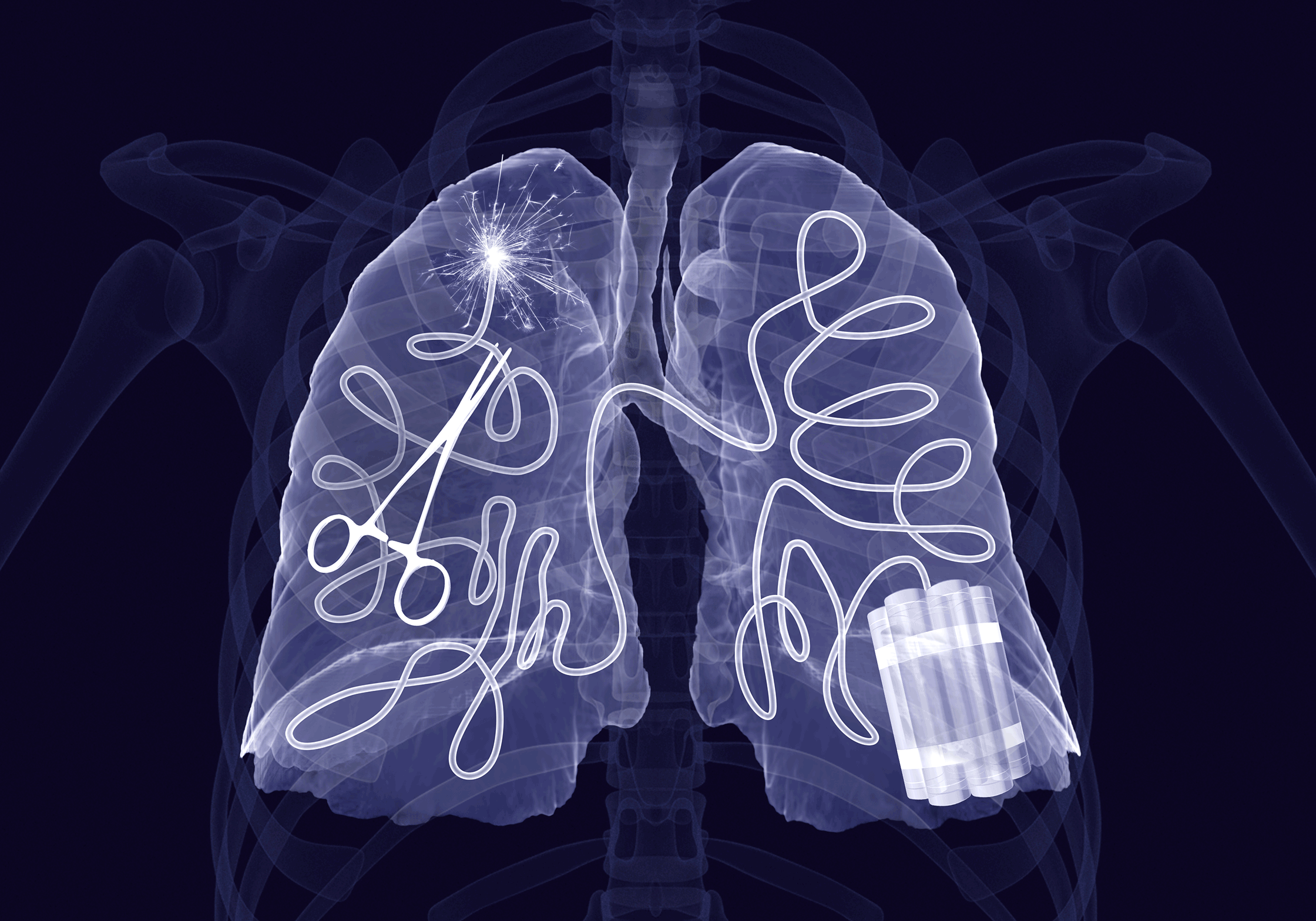Pulmonary Partners
Medical and engineering students harness AI to detect life-threatening embolisms
By Josh Baxt
Illustration by John Kuczala

A
group of students from the Miller School and University of Miami College of Engineering has come together to create Smart Scan, a potentially lifesaving technology that helps detect pulmonary embolisms, or PEs, and identify patients who need immediate care.
Pulmonary embolisms — blood clots in the lungs — kill about 100,000 people in the U.S. each year. PE is the third most common cause of cardiovascular death, and mortality rates have been rising for still-undetermined reasons, although COVID infections appear to be a factor. Patients who do survive a PE often suffer from chronic lung conditions for the rest of their lives.
PEs need to be diagnosed quickly, but in a busy emergency room, a patient with moderate breathing problems may be overlooked. To complicate matters, PEs can be difficult to detect on X-rays or CT scans.
“Sometimes a patient looks like they are doing fine, but they actually have a time bomb inside their body,” said Noel Ziebarth, Ph.D., associate professor of biomedical engineering. “Smart Scan uses AI to analyze chest X-rays or CT scans to identify PE and get those patients the attention they urgently need.”
Miller School third-year students Guarav Gupta, Kenneth Richardson and Ronald Swonger and UM biomedical engineering undergraduates Ryan Fisher, Beatriz Guevara and Janette Herr collaborated to create Smart Scan, which was named Best Biomedical Engineering Project and Best Expo Poster at this year’s College of Engineering Design Expo at UM.
Cross-Pollinating Medicine and Engineering
With this project, Gupta, Richardson and Swonger are fulfilling their requirement for 150 hours of mentored research. This concentration was added to the Miller School’s NextGenMD curriculum two years ago to help produce well-rounded physicians who have in-depth research experience. A biomedical engineering class sets the stage, providing exposure to the entire flow of medical product development, examining how things are done in the clinic, developing ideas based on these observations and translating those ideas into actual designs. In addition, students learn about other business considerations, such as FDA regulations, intellectual property and marketing.
“They learn how to observe things in the clinic, identify how current processes may not be the best way to do things, and come up with better ideas,” said Dr. Ziebarth, who is the graduate program director of biomedical engineering and who teaches the course. “From there, they have to develop a design, something mechanical or maybe a software program.”
“Engineering students have the technical expertise, but they don’t have the experience. Medical students are seeing problems like PE detection during their rotations and can help the engineers design a technology that will work in the real world.”
This training and the associated project work provide new insights into how medical tools are developed and can change students’ perspectives on problem solving.
“I have always been fascinated with the idea of engineering and product development,” said Richardson, who is in the Miller School’s Class of 2024. “Project Smart Scan made me realize that I can still pursue that dream. I intend to go into interventional radiology, but Smart Scan showed me I can continue working on engineering products throughout my career.”
After completing the engineering class, the medical students team up with biomedical engineering undergrads who are fulfilling their senior-year capstone project, which matches them with industry partners to solve health care-related problems.
“We combine medical students with undergraduate engineering students and put them together to come up with a design solution to some sort of clinical need,” Dr. Ziebarth said. “The engineering students have the technical expertise, but they don’t have the experience. The medical students are seeing problems, like PE detection, during their rotations and can help the engineers design a technology that will work in the real world.”
These projects can be powerful educational tools, giving medical students and engineers unexpected perspectives on problem solving for a clinical environment. In addition, they allow students to participate in multidisciplinary teams that combine electrical and/or mechanical engineers, clinicians, lab researchers and others.
With the Smart Scan project, the medical students understood the difficulty of detecting PE. The engineers took this input and translated it into solutions — in this case, an artificial intelligence algorithm that helps physicians identify and triage PE patients.
“The process of developing and optimizing the algorithm by following how the CT scans were processed and analyzed gave me a greater understanding of the pathogenesis of the disease, as well as image pre-processing and visualization,” said biomedical engineering student Janette Herr. “The knowledge I gained from this project refined my programming and image analysis abilities.”
Success at the Expo and Beyond
The Design Expo is a focused version of the television show Shark Tank. Participants are given fake money to invest in promising projects. The students woo potential investors with posters, videos and other support materials. It gives them added experience pitching their ideas.
Smart Scan got high marks because it could have a major impact on patient care and is a highly practical solution. This technology could be easily integrated into clinical workflows, providing additional information to clarify scans physicians are already examining and triage patients more effectively.
“This project opened my mind to the possibilities of working with big data in science,” said Guevara, who, unlike her engineering teammates who have graduated, remains in COE’s B.S./M.S. dual-degree program. “Machine learning and AI are, I believe, the future of image processing and analysis, because they alleviate the workload on physicians and medical staff and give accurate and predictable results.” ![]()



